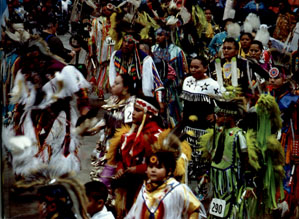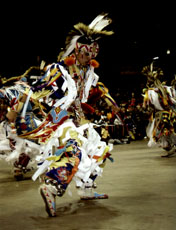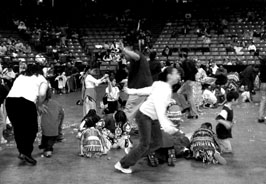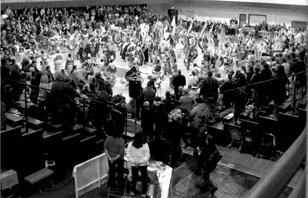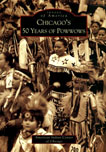|

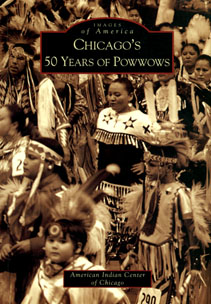 |
Chicago's Fifty Years of Powwows |
<Adapted from the book of the same name>
Introduction: What is a Powwow? The powwow is at once a celebration and extension of Indian traditions through the arts (visual and performance) and a critical vehicle for transmitting those traditions to our younger generation. Although traditional aspects of Native American culture have evolved and are still practiced in urban centers, it is conveyed that respective Indian Nations who reside in Chicago culturally exchange among themselves through powwow culture. Powwows are places and time to rekindle old friendships, reaffirm traditional values, share, and introduce the vivid and vital spectacle of contemporary Indian culture to the larger Chicago community.
Historically, powwows evolved from ceremonials of the Grass Dance Societies that formed during the early 1800s. Over a period of time, Indian relations with the government translated toy ceasing a myriad of tribal customs and religious practices. However, the Grass Dance was one of the few celebrations allowed into this new era. As other communities and tribes were invited to these celebrations, rights of ownership of sacred items of the Grass Dance were transferred from one tribe to another. Intertribalism commenced with the sharing of these songs and dances.
There are several different kinds of powwows (e.g. memorials, birthdays, fundraisers, etc.), however, the two most common are known as traditional and competition powwows. Traditional powwows are executed for purposes of honor in traditions; retaining and celebrating Native values.
Spectators enjoy contemporary Native American cuisine (diverse foods from respective Tribal Nations), purchase various art items and thematic Native products, and watch dancers and singers compete for the right to be named champion. Significant prize money is involved with competition powwows. It is important to note that most of the consecrated ceremonies are no longer part of the powwow (e.g. naming ceremonies are now conducted in the privacy of the family), but honoring ceremonies remain today.
The photographs in this online essay document a half century of the powwow experience.
Forward to the next page of this essay Back to Online Essays
|
| |
Department
of Anthropology |
copyright ©
2002 University of Illinois, All rights reserved. |

